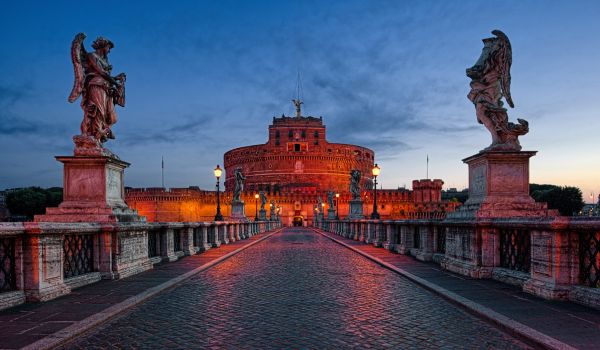
Castel Sant’Angelo is a famous landmark in Rome, Italy. It is an impressive fortress that has served many different purposes throughout history. Today, it is a popular tourist destination, but it was once a military building, a papal residence, and even a prison.
History of Castel Sant’Angelo
Castel Sant Angelo history is very unique as it was originally commissioned by the Roman Emperor Hadrian in 135 AD as a mausoleum for himself and his family. The structure was completed in 139 AD and was originally known as the Mausoleum of Hadrian. The mausoleum was used for its intended purpose until the fall of the Roman Empire in the 5th century.
In the 6th century, the mausoleum was converted into a fortress by the Byzantine Empire. It was during this time that the statue of the Archangel Michael was placed on top of the building. The statue was added as a symbol of protection for the fortress.
The fortress was used as a military building for many centuries. During the Middle Ages, it was used to defend Rome from invading armies. In the 14th century, it became a residence for the popes. The papal apartments were added to the building during this time. Popes would use Castel Sant’Angelo as a refuge during times of danger.
In the 16th century, Castel Sant’Angelo was used as a prison. The prison was notorious for its harsh conditions and was used to hold political prisoners. The most famous prisoner to be held at Castel Sant’Angelo was Giordano Bruno, who was imprisoned for his beliefs about the universe. Bruno was eventually burned at the stake in the Campo de’ Fiori in Rome.
During the 19th century, Castel Sant’Angelo was used as a barracks for the Italian army. In 1901, it was opened to the public as a museum. Today, it is one of the most popular tourist attractions in Rome.
Architecture of Castel Sant’Angelo
The architecture of Castel Sant’Angelo is a combination of Roman, medieval, and Renaissance styles. The building is circular in shape and is surrounded by a moat. The entrance to the fortress is a drawbridge that crosses the moat.
With Castel Sant Angelo tickets, get a chance to explore the statue of the Archangel Michael on top of the building is a prominent feature of the architecture. The statue is made of bronze and stands over 4 meters tall. It is said to have been designed by the 17th-century sculptor Gian Lorenzo Bernini.
The papal apartments are located on the top floor of the fortress. They were added during the 14th century and were used by the popes as a residence. The apartments are decorated with frescoes and tapestries that depict scenes from the Bible and from Roman history.
The prison cells that were added to the fortress in the 16th century are located on the lower levels. The cells were small and cramped and had no natural light. Prisoners were often kept in these cells for years without trial.
Today, the fortress is home to a museum that houses a collection of art and artifacts. Visitors can see the papal apartments, the prison cells, and the collection of art and artifacts during their visit.
Significance of Castel Sant’Angelo
Castel Sant’Angelo has played an important role in the history of Rome. It was originally built as a mausoleum for the Roman Emperor Hadrian and his family. It has also served as a fortress, a papal residence, and a prison.
The building is significant for its architecture, which is a combination of Roman, medieval, and Renaissance styles. It reflects the evolution of architectural styles throughout different periods in history. The circular shape of the fortress and the imposing statue of Archangel Michael contribute to its iconic and recognizable silhouette, making it a symbol of Rome’s rich heritage.
Castel Sant’Angelo holds great historical and cultural value for Rome. It witnessed significant events and housed notable figures throughout its existence. As a military stronghold, it played a crucial role in defending the city during various conflicts. Its strategic position on the banks of the Tiber River made it an ideal defensive structure.
In conclusion, Castel Sant’Angelo stands as a testament to Rome’s vibrant history and architectural grandeur. Its transformation from a mausoleum to a fortress, a papal residence, and a prison showcases the evolution of Rome through different eras. Today, it welcomes visitors from around the world, allowing them to immerse themselves in the captivating narratives woven into its walls. Castel Sant’Angelo stands as a symbol of Rome’s enduring legacy and a remarkable testament to the city’s cultural and historical significance.
